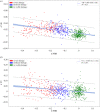Implications of tropical cyclones on damage and potential recovery and restoration of logged forests in Vietnam
- PMID: 36373926
- PMCID: PMC9661952
- DOI: 10.1098/rstb.2021.0081
Implications of tropical cyclones on damage and potential recovery and restoration of logged forests in Vietnam
Abstract
Many natural forests in Southeast Asia are degraded following decades of logging. Restoration of these forests is delayed by ongoing logging and tropical cyclones, but the implications for recovery are largely uncertain. We analysed meteorological, satellite and forest inventory plot data to assess the effect of Typhoon Doksuri, a major tropical cyclone, on the forest landscapes of central Vietnam consisting of natural forests and plantations. We estimated the return period for a cyclone of this intensity to be 40 years. Plantations were almost twice as likely to suffer cyclone damage compared to natural forests. Logged natural forests (9-12 years after cessation of government-licensed logging) were surveyed before and after the storm with 2 years between measurements and remained a small biomass carbon sink (0.1 ± 0.3 Mg C ha-1 yr-1) over this period. The cyclone reduced the carbon sink of recovering natural forests by an average of 0.85 Mg C ha-1 yr-1, less than the carbon loss due to ongoing unlicensed logging. Restoration of forest landscapes in Southeast Asia requires a reduction in unlicensed logging and prevention of further conversion of degraded natural forests to plantations, particularly in landscapes prone to tropical cyclones where natural forests provide a resilient carbon sink. This article is part of the theme issue 'Understanding forest landscape restoration: reinforcing scientific foundations for the UN Decade on Ecosystem Restoration'.
Keywords: Southeast Asia; forest biomass; logging; tropical cyclones.
Figures






References
-
- Hu J, Herbohn J, Chazdon R, Baynes J, Vanclay J. 2020. Above-ground biomass recovery following logging and thinning over 46 years in an Australian tropical forest. Sci. Total Environ. 734, 139098. - PubMed
Publication types
MeSH terms
Associated data
LinkOut - more resources
Full Text Sources
Medical
Research Materials
